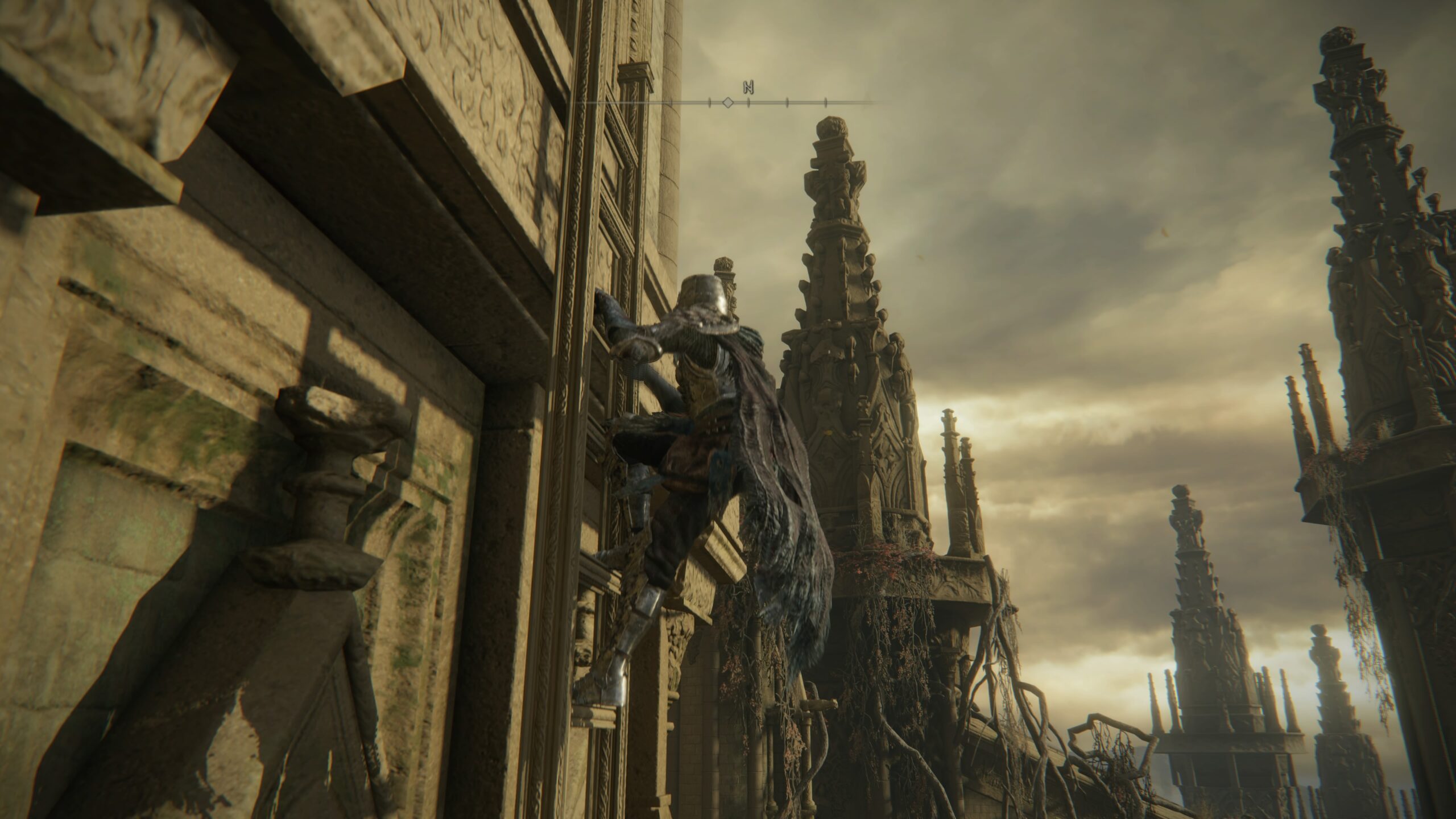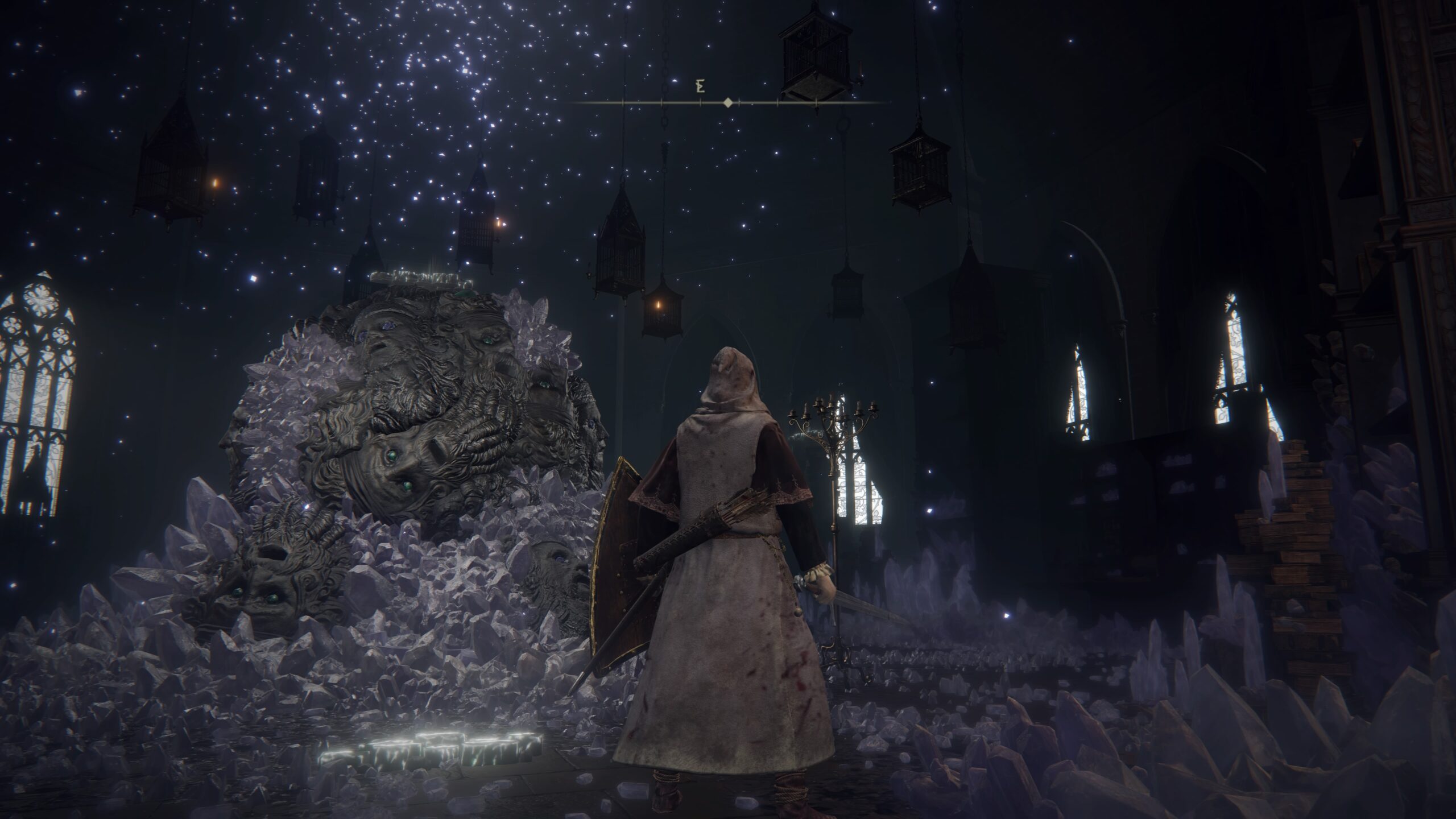REVIEW: Elden Ring (2022)
A Masterpiece Showing Its Stretch Marks
Elden Ring is the latest action RPG Soulslike epic by FromSoftware. The studio known for challenging boss fights and labyrinthine dungeon design had a lot to live up to after its award-winning samurai adventure, Sekiro, and live up to it they did with a 100+ hour open-world adventure and more characters and enemies than you can probably find time for. Making your first massive open-world game – and with the complex DNA of a Dark Souls game to boot – is no easy feat, yet FromSoftware drops it fresh from the forge like they’ve been doing it as often as Ubisoft or Rockstar Games. The open world in Elden Ring is so effortlessly realized and adapted to the Souls formula that it’s almost shocking, for better and worse.
Performance and Art

What’s not so shocking is the quality of the visuals and the gorgeous art style permeating Elden Ring’s vast world. FromSoftware is known for creating atmospherically captivating locales, and Elden Ring contains some of their best artistic work yet. The omnipresent golden tree in the center of the world casts some beautiful contrasts with the fauna, mountains, and colorful skybox above them. The dynamic day/night cycle of the open world does an excellent job highlighting the rich artistic vision of the game world, with changes in lighting and shade illuminating the numerous vistas seen throughout the game. The skybox, with its moving clouds mixing with the volumetric lighting of the golden erdtrees and blue moon hues, remains a visual treat throughout.
Playing Elden Ring on PS5 almost convinces me that ray tracing should be an essential component of next-gen design. The god rays and colors noticeably pop when played in quality mode on high-end PCs and PS5/Series X, though the performance takes a bit of a hit as a result of the 4K visuals. It’s also not very shocking that on launch day, Elden Ring suffered performance issues and numerous bugs of the software variety. Frame stuttering was a consistent problem at launch, as were crashes and glitches, though many of these issues have since been patched. I played the majority of the game on quality mode, where the fps fluctuated at around 30 fps most of the time. The stutters are distractingly apparent when playing on quality mode, but again, I just couldn’t help myself with the impressive lighting and colorful visuals.
Quality of Life
Elden Ring is a visual masterpiece, but all the prettiness in the world doesn’t mean much if you can only look at it from afar. Thankfully, there’s plenty of quality content and fun to be had between moments gazing off at the distant vista and admiring the view. And boy, there’s A LOT of content here, and it’s more accessible and easier to dig into than ever before. If you’ve never gotten into the Soulsborne games due to lack of convenience and archaic design, Elden Ring’s optional tutorial and open-world commodities may just woo you in for good. Worth noting right away is Elden Ring’s solution to the “banging your head against a wall” problem many players encounter in Soulsborne games. This is almost completely obliterated in Elden Ring due to the sheer number of activities the player has available to them at any moment. Stuck on that annoying boss that’s taking way too long to beat? No problem; just wander over to that hillside with gravestones poking underneath and loot some precious runes (this game’s “souls” currency), or do a couple of runs through some mines you walked past on the way to the pesky boss.
Another convenience players will surely appreciate is an unobtrusive waypoint system in the form of “guidance of grace” that directs the player through streams of light to the “main path” the game intends. I like how integrated into the setting’s lore the guidances are; it’s more organic than the tacky objective markers littered across the maps of other open worlds. And then, there’s the host of smaller quality of life features that raise Elden Ring’s accessibility further. Fast travel is available right out of the gate, stamina no longer degenerates outside of combat, and checkpoints in the form of Marika stakes are closer to boss rooms and general points of interest. Build yourself into a corner with a terrible build? Respeccing your attributes, skills, and how your character looks are available early on and without hassle or consequence. The most fun convenience feature of them all is the dedicated jump, which can be used outside of combat for the usual navigation convenience over terrain and in combat with new jump attacks, which are very powerful and often break enemy poise. Being the open world that it is, Elden Ring capitalizes on jumping with several platform segments and environments, such as these ceiling rafters:

My first character specialized in jumping attacks with colossal weapons, which I’m happy to report is a very, very satisfying style of play. There are many different styles of play here, with a plethora of weapons and armor with which to experiment. All these options and conveniences may give the impression that the developers at FromSoft dumbed the game down and streamlined the experience to cater to casual players, but this isn’t at all true. Yes, it’s possible to cheese fights through some overpowered spells (of which there are many!) and builds, but they don’t work in all circumstances. Some areas and bosses will straight up destroy the cheese method one may have employed in the previous area. Some enemies and bosses are immune to certain status effects and attack types, such as hard-skinned enemies being resilient against bleed.
In this sense, Elden Ring is more of an RPG than previous entries, often requiring equipment management and strategy instead of relying on your trusty colossal hammer for every situation. In fact, the final leg of the adventure is perhaps tuned a little bit too high in difficulty even by FromSoftware standards, but more on that later.

Don’t get your hopes up; there’s still no easy mode in Elden Ring, and the core gameplay remains just as challenging as previous games from the studio. The user-friendliness in Elden Ring comes in the form of easing the player into this challenging gourmet and helping them through it with various means, most notably the spirit summons. The gourmet is still the tough, rich steak it’s always been; it’s just easier to dig into due to the variety of silverware accompanying it this time.
There’s the whole online component, with player messages helping or trolling players on where to go and how to proceed, which I found charmingly enjoyable. Co-op is mostly the same as previous games in that you can use an item to look for live co-op partners in dungeon areas and during boss fights, summon yourself as help, or invade/be invaded by hostile players. This online component is all optional and remains a fun aspect of the community of the game, which always seems active. This time, NPC summons play a more prominent role in the player’s arsenal than ever before.
Spirit ash summons are perhaps the most powerful tool at the player’s disposal, though it’s sometimes circumstantial. Ever wanted to be a summoner class in a Souls game where you can conjure up the walking dead at your will and command them into battle like a Diablo Necromancer? Well, that’s possible here. Though you can’t control your summons directly, there’s a charming connectedness I formed with the many summon creatures throughout my journey in the Lands Between. By extension, the spirit ash descriptions function like a bestiary of the various creatures encountered in the Lands Between. Some are more common than others, like the undead, but there are also champions and legendary ashes, which sometimes come in the form of mini-bosses or even NPCs in the world.
Like the variety of spirit summons, weapons, and items to collect in the world, there are also ashes of war. Ashes of war attribute your weapon with a quality type, such as bleed, flame, or magic, and give your weapon a unique special ability. The cool thing is, you can freely equip any ash of war to almost any weapon in the game without penalty. Even bows and shields have their own unique ashes of war. I wanted to “catch” all the ashes of war and spirit summons I could, like Pokémon, which inevitably led me to explore off the beaten path more often than I would have in search of my next special ability or pet to level up.
Though, while Elden Ring rewards exploration and populates the open world with a constant stream of things to do and collect, at a certain point in my time in the Lands Between, I just wanted to get on with the main content of the game and leave further exploration for playthrough number two. Part of my wish to avoid side content is simply to preserve an element of surprise and newness for subsequent playthroughs, but there are a couple of legitimate underlying problems that the open world format runs into when mixed with the Soulsborne genre.
The Open World
The open world in Elden Ring is something of a double-edged sword; it’s wonderful when you want to explore and do side stuff but feels like empty space when you just want that tightly crafted FromSoft level design at all times. There’s no doubt that FromSoftware has triumphed in crafting an exceptionally made open world, though, so I’ll begin with the pros rather than cons.
From that first revelatory freedom point rising out of the tutorial cave and seeing the bright erdtree in the distance with open-ended land sprawling in front, one can tell they’re in for a beautifully designed game world. Elden Ring’s world is filled with wonder, mystery, and rich atmosphere, each zone feeling unique in flavor. I love the constant reference point of the giant golden erdtree looming in the center of the world. The draw distances in this game are some of the best I’ve seen, with distant vistas of castles and mountains captivating the player to wonder what adventures await. It’s incredibly satisfying to finally explore the distant castle and look back at the location you used to view it from earlier in the journey. Sure, it’s obvious the graphical models of these locations in the distance are compressed and low resolution at times, but they’re still modeled accurately to their up-close counterparts. I was consistently impressed by the impressive visual continuity from every corner of Elden Ring’s world.
And what better way to compliment a beautiful landscape than some beautiful background music, right? Well, every location in Elden Ring is accompanied by atmospheric music, for better and worse, although beautiful isn’t exactly the most accurate description for much of it. Gone are the silent trips through caves, dungeons, and churches. Now, even catacombs have their own eerie theme music. Each zone of the overworld has its own unique background music. This music is very minimalistic and usually punctuated by dissonant strings and horns. For me, some of the music was too persistently dissonant, almost doggedly so. The starting zone, Limgrave, has this shrill, high-pitched drone string that constantly hovers through a subtle whirl of dissonant undertones. It gets across the eerie, twisted, sometimes hauntingly beautiful visuals of the world, but it quickly became irritating and repetitive after a while in some of the zones, resorting to me playing it the old-fashioned, music-less way through areas like Limgrave. The rest of Elden Ring’s soundtrack is pretty much par for the course for a Soulsborne game. The bosses have loud and chaotic choirs accompanying them, and the hub areas have a sad and resigned quality. Overall, I didn’t find the soundtrack to be a strong element of the game. Personally, it’s my least favorite of the Soulsborne soundtracks, but music is subjective, so I won’t belabor the point. But, man, the loud choir style is really getting old for me at this point.

So, Elden Ring’s world has an artistic flair all its own, but how fun is the open world from a gameplay perspective? The environments themselves feel natural and not Speedtree spammed. There is a conscious effort to make the world feel “alive” and organic. The spacing between points of interest is almost ideal for an open world, especially made denser when galloping on horseback, though you do notice some of the empty space the more you play.
And boy, the horseback riding controls very well. The turning radius on the horse is tight, and the speed at which you can gallop is exceptional without being broken. The double jump is a godsend. I rarely found any terrain that was annoying to ride the horse around due to Torrent’s (your horse) nimble and super responsive input. I’m very thankful the horse riding isn’t laborious for the sake of realism. I never quite felt like I was wasting my time exploring the world or doing stuff that didn’t yield some interesting equipment, experience, or boss battles. There’s always something worth doing that will aid the Tarnished’s journey to become the Elden Lord, yet the repetitive stuff in the open world still left a bitter taste that made me dislike the open world the more I played it.

Despite FromSoftware knocking it out of the park on their first attempt at open-world design, a valuable aspect of the Soulsborne design was sacrificed in the process. That is, the various points of interest and general open environment lack much of that tightly crafted, bespoke level design that FromSoftware has been known for since Demon’s Souls. There was almost no empty space or areas designed merely as traversal roads/land back in Demon’s Souls and Dark Souls. Almost every inch of space in the early Souls games was paced like intricately designed dungeons closely connected with one another. In other words, no fields. The first Dark Souls was more open-ended than Demon’s Souls yet still retained that tight, compact, intricately detailed design that made every step feel especially meaningful and curated.
While Elden Ring’s open-world environments are better than other open-world games in terms of density and interesting art design, it still lacks that tight “every step is special” design that seemed to permeate every square foot of the past Souls games. Don’t take this as a scathing critique; Elden Ring’s world is decently dense, just not as consistently compact as the previous games in the genre. Think of Elden Ring’s open world as the preparation for the legacy dungeons, the “main” dungeons of the game. You get lots of gear, levels up, and currency through the various locales of the open environment, which, in turn, help with the exceptionally more difficult and intricately designed legacy dungeons and their often brutal bosses (especially late game).
The open world is artistically remarkable and adds leisure to the pacing, yet can sometimes feels like an extended edition director’s cut of a film with all the extra filler included. My final words on the open world experience: fewer smiles per mile, more miles with more overall smiles. Bigger isn’t always better.
Caves, Catacombs, and Checklists, Oh My

Perhaps the most formulaic aspects of Elden Ring are the various points of interest on the world map, of which there are many. While not as repetitive and chore-like as a Ubisoft world map with hundreds of markers signifying towers, forts, and a whole checklist of stuff, it does have an easily recognizable pattern. This pattern comes in the categories of the points of interest: caves, mines, forts, ruins, divine towers, churches, evergaols, outpost camps, etc. The way these points of interest are strewn about the world thankfully feels organic, with good thought put into it. It hardly felt like I was just running through a menial checklist of chores to do in each area of the map; hardly. Though, I have to say that the nagging awareness that these caves and ruins are a formulaic design was practically omnipresent throughout my time.
Many of the caves, however, do have unique layouts with hidden passageways stowing away valuable weapons or amulets. One cave led me to an island across the shore, another to a hidden nook on top of a mountain. The various points of interest have enough unique design not to feel too repetitive or copy/paste, but keen players can still notice the similarities and shared design since they share assets and props across their specific category. Some of these function as mini-dungeons with a small boss at the end – perfect for a quick co-op session to get more runes and items. I particularly enjoyed the little puzzles in the various catacombs; they add some nice gameplay variety to spice up what would otherwise be a repetitive clearing out of imps and skeletons. When the player begins to notice the clear patterns of these locations and the rewards they give, it becomes easy to intentionally hunt for specific materials and items you may need, such as the precious golden seeds or ashes of war usually housed within the catacombs. This predictable pattern of activities in the open world can be seen as both formulaic repetition or a reliable reward, often both.
It’s this paradoxical open-world design of Elden Ring that makes it somewhat complex to review for me. I simultaneously welcome the obvious advantages of predictable rewards and more content and lament that FromSoftware has essentially sacrificed a bit of their tightly focused and bespoke design across 90% of a game that was so admirable and unique. For many players, the increase in content and tangible rewards will be a significant improvement; to others, it will sting of a minor Ubisoftification of the Souls formula.
Gaming Heaven

But there’s one thing about Elden Ring that I absolutely adore without reserve, and that’s the legacy dungeons. These dungeons are the core of Elden Ring’s main game progression and fully display the classic tight FromSoft level design in games like Demon’s Souls and Dark Souls. I can’t think of a legacy dungeon I didn’t enjoy immensely in Elden Ring. They’re simply some of the best level designs FromSoftware has come up with. Sites of Grace are wonderfully paced throughout the legacy dungeons, with a very small number of exceptions, and there’s a delightful abundance of shortcuts connecting the beginning of the dungeon to the end. Whether it’s unlocking a previously barred door leading you straight to the boss room or kicking a remote ladder that leads to the end of the dungeon, these moments of the dungeon looping in on itself surprised me and reminded me of classic Dark Souls 1 design time and time again.

There’s one labyrinthine sewer level, in particular, that has that Dark Souls 1 design philosophy and atmosphere in spades. It felt like a real sewer system you might encounter in a dark fantasy setting, not like a team creating a level from a checklist. Every corner has a uniqueness to its design and a personal touch that makes it immersive and truly atmospheric. Every corner of that sewer system felt different. No copy/paste rooms, scenarios, or ideas whatsoever. It felt wild and organic and magical, a feeling only the best FromSoftware levels can give. I was even surprised to see a familiar enemy jump out at me from a dark hallway, surprising me with an equal measure of nostalgic delight and horror. The enemy placement, treasures, and traps in these legacy dungeons are all expertly crafted with the deft hand of a genius dungeon master, and while no dungeon quite matched the intricate genius of Sen’s Fortress in Dark Souls 1, some come startlingly close.
Another dungeon had my character traversing the branches of a giant tree with numerous branches below housing treasure and… giant fire ants. A feeling of wonder washed over me as I descended onto a Kashyyyk-styled village high atop the trees. The architecture of the tree structures reminded me of Lothlorian from Lord of the Rings and displayed some of my favorite imagery of the entire game. The architectural design throughout Elden Ring is stunning, by the way. I had the time of my life navigating the enchanted tree village until I arrived at the boss at the end. It was a replica of a boss battle I’d already defeated much earlier in the game, the only difference being elemental attacks and improved stats. This type of fight was a buzzkill for me and one that occurs more than a couple of times in Elden Ring.
Battles, Builds, and Bosses
Repeat boss battles are nothing new in games; Mega Man 2’s wily castle robot master fights even had them. And, yes, Dark Souls had some bosses that appeared as regular enemies in later levels. Elden Ring’s reuse of bosses feels more irritating than usual, though, partially because the design boils down to merely upping the stats and making the fight more laborious. There’s one mandatory sentinel boss fight that employs the same exact attack patterns as the very first horserider boss you encounter in the game, and it’s just not interesting or fun doing it for the fifth time.
Dragons are similarly populated throughout the Lands Between and, unfortunately, similarly reskinned. The first couple of times you fight a dragon in Elden Ring are amazing. Riding horseback and dodging a giant dragon’s fire breath as it lays waste to the land around you is thrilling and one of the more exciting examples of horseback combat I’ve experienced in gaming. However, these boss fights get reused often throughout the game and require a bit more preparation crafting berries for Torrent so you’re not left without a horse during the battle. It gets irritating after a while, to the point where I almost lost motivation to play when encountering another one later in the game.
Thankfully, not all bosses are repeats. Some of the biggest boss fights come in the form of the various demigods and the remembrances they leave for the player on defeat. These are Elden Ring’s “big bads,” so to speak, the major movers and shakers you’re told about from the intro of the game. Even some of the demigod boss fights are laborious and not fun. One notorious boss, in particular, has a gimmick that can only be described as ridiculously unfair and downright aggravating. Remove the gimmick, and the fight turns into a potential FromSoft great. I know I’m being vague, but trust me when I say it’s one of the company’s most troll gimmicks yet, and they’ve done a lot of troll things to players in these games.
To get to the broader point, some bosses are just obviously too overtuned, anticipating a higher-level character using all the tools at their disposal or a specific build. It’s very difficult to balance boss battles in an open-world game to be just right for everyone’s current level and build. And while nobody expects a perfectly balanced difficulty curve that scales with the player, there are just too many lopsided cliffs in difficulty that impede progress and force exploration and grind, whether the player wants to explore or not. It’s hard to thoroughly enjoy an open world when you feel strong-armed into grinding around through it to reach a particular power threshold for the boss to continue, but maybe that’s just me. This kind of “level gating” slightly reminds me of the artificially overpowered enemies in Assassin’s Creed Odyssey. In that game, you’d better explore ancient Greece to near 90% before progressing further in the main story or buy the microtransactions that level you up because you’re going to get stomped no matter your skill level. The boss health in Elden Ring is similarly bloated, with bosses dealing damage that can often one-shot a character if their build isn’t a certain way and they’re below a certain level. By the way, my advice: put a lot of stats into vigor early on.

Elden Ring has ways around a potentially broken build, thankfully. A respec option to rebuild your character’s attributes to better oppose a specific boss is widely available, and without too great a cost. Still, I do feel like the level of specialization the game expects at certain points is counter to the design philosophy of an open-world game in the first place.
The difficulty curve in early and late-game could’ve used some more work and testing, and some of the bosses are just way too overtuned for their areas. The earliest example of this difficulty cliff problem is the first major boss fight players will encounter in the game, Margit, at the entrance to Stormveil Castle. It’s a wonderfully designed boss fight in and of itself, with many different moves for every situation and a one-on-one battle that rewards mastery of the combat and the various tools available to the Tarnished. Unfortunately, amazing boss fight though it is, it’s too overtuned for a starting character. It’s obvious the game wants you to give up and explore elsewhere until you’re high enough level to fight Margit again and finally enter the first real legacy dungeon of the game. I just don’t find this kind of difficulty curve satisfying. It’s forced exploration, which could work in an open-world game, but not in one that specifically guides the player directly into the castle from the beginning. The open world functions partially as preparation for the legacy dungeons, yes, but instead of being a gentle curve in difficulty, Margit is a cliff without warning or previous preparation. The middle of the game is where the curve is the most balanced, and it’s not that bad once you get the memo that you should be taking full advantage of the world’s tools and resources. I’m not against a good difficulty cliff by any means, but Elden Ring’s just feels skewed and lopsided at times.
At least the reskinned and overtuned fights don’t comprise the vast majority of the boss battles in Elden Ring: some bosses are incredibly fun and memorable. Without spoiling, the final boss in the game is an all-time favorite of mine. If you like the tight rhythm and fairness of the one-on-one duels in Sekiro, you’re going to love this one. Gameplay and story are integrated brilliantly with the final boss, combining Elden Ring’s overarching themes through visual storytelling and exciting gameplay. It’s truly a spectacle worth playing the rest of the game to see. And, of course, this kind of visual storytelling isn’t just found in boss battles; it’s strewn throughout the game’s environments, character quests, and all-too-notorious FromSoft item descriptions.
Story and Lore

Like previous Soulsborne games, much of Elden Ring’s story and lore is uncovered through the interesting, though often vague, item descriptions. Considering Elden Ring has the most items of any of FromSoft’s games to date, that’s a lot of story to put together. And put it together the player must, since the way the story is told in these games is like fitting puzzle pieces together.
One thing I really appreciated about Elden Ring is how strong the environmental storytelling is. You might be stumbling along a fort to see demi-humans in the middle of a desperate battle against knights defending their keep, only to discover through an item or NPC in a room that the demi-humans are revolting against the inhumane slavery to which the knights were subjugating them. The atmosphere and tone of the environments also do an amazing job implicating the lore of an area. Such is the case with the blighted Caelid, one of the more artistically interesting locations in Fromsoft’s rich history. A majority of players may even stumble upon the blighted wastes of Caelid early on in the adventure since it’s fairly close and accessible from the starting zone, Limgrave. From the enemies to items forgotten in random piles of rubble to area-specific status ailments, there are a lot of different avenues through which the game displays environmental storytelling, and it’s one of the more well-done examples across the Soulsborne genre.
One of the other aspects of Elden Ring’s world I was delighted to encounter was an unusually strong cast of characters to interact with, both important and tangential. FromSoftware has a tendency to make lonely worlds where the few surviving characters are relegated to hub status, servicing the player through smithing, leveling up, or teaching sorceries, or characters that just stab you in the back. Elden Ring has these roles in traditional fashion too, but there’s a wealth of characters strewn about the open world on their own journeys with unique insight into the lore of the Lands Between.
Almost every NPC you encounter in the game has a quest chain that either rewards you upon completion or opens up one of the six endings from which to choose. I found these quests satisfying in the way they connected me to the world and counteracted the loneliness these kinds of worlds can instill in the main protagonist. I liked almost all the characters in this game.

Alexander the Jar is charming and entertaining and, overall, just a good bro, Ranni the Witch is sympathetic and has a ton of lore and insight into the world (she was the storyteller from the cinematic trailer, after all), and the denizens of Volcano Manor are absolutely fascinating in their own twisted and unique way, hiding a conspiracy waiting to be unmasked. Excellent voice acting accompanies all these characters, and it’s always rewarding to exhaust their dialogue.
The story, lore, and characters of Elden Ring are rich and wonderfully written, which is why it’s a bit disappointing to me just how difficult and laborious it can be to access them. If you went into Elden Ring thinking you won’t use a walkthrough, oh boy, that’s going to be a tall task. Not because the game is just that difficult to get through, but because it takes an encyclopedic comprehension and mind map to put together all the pieces of Elden Ring’s story. Likewise, to complete many of the character’s questlines, a walkthrough is almost necessary. Regarding the rich lore that George R.R. Martin may or may not have really been involved in, I only faintly grasped at what was going on about 20 hours in when more item descriptions and hints were given that implied what exactly the “greater will” and “golden order” are. Elden Ring has a venerable vocabulary of events, religions, factions, and concepts all its own that it dishes out like candy from the beginning of the game. To its credit, the world feels natural, and the exposition doesn’t treat you like a dumb person playing a game for the first time. It’s all presented as if these characters have existed for decades in the situation you start the game in, and that’s because they have.
But the character quests needing a walkthrough is certainly more worthy of genuine complaint since it’s a gameplay problem, one that can be solved with a simple quest log. I couldn’t keep track of what each character was doing at different parts of their questline. Some just disappear off the map entirely until you discover them in a different location or fulfill an event trigger about which you weren’t given the slightest hint. Sometimes the quests are time-gated and abruptly end without the player knowing. I failed numerous character quests merely by advancing the main story a bit, and because the game only allows for one save file stuck in an ironman mode, you can’t save-state and go back to redo stuff you missed or didn’t do in time. I know some enjoy the cryptic anti-hand-holding nature of the quest design here, but I find it ultimately frustrating and incredibly cumbersome and always have since the first Souls games. Relying on outside resources like a separate computer or phone open to a walkthrough or the cinematic trailer that explained the story better than any in-game cinematics, is just frustrating when you are sitting down solely focused on the game you paid $60 to buy. This crucial information should just be available in-game, but alas, this is just an extension of FromSoftware’s cryptic design philosophy, and people will either love it or hate it.

Love it or hate it: that’s more or less been the legacy of FromSoftware’s games since Demon’s Souls, but perhaps for the first time, Elden Ring demands enjoyment and respect from just about everyone. The wider appeal of Elden Ring could be attributed to its open-world design allowing freedom or to all the quality of life features, but it’s certainly FromSoft’s most popular title yet. The genre of Soulsborne games didn’t begin with universal praise and game of the year awards; it was somewhat niche and almost archaic. This fresh, archaic design always fascinated me and lured me further into the game’s intricacies. I absolutely adore the organic way Demon’s Souls and Dark Souls present themselves. There are no real tutorial pop-ups, no five-minute-long exposition dump, and then there’s the generally unforgiving gameplay design that challenges stubborn people like me to overcome its difficulties. But with this design philosophy obviously comes frustration and poor quality of life elements. Thankfully, Elden Ring has more quality-of-life upgrades to its gameplay than the previous games. Being able to respec your character build without penalty, better spaced-out checkpoints, little penalty for death compared to previous games, stamina that doesn’t deplete outside battle, and one of the more enjoyable horses in gaming; these are all wonderful conveniences in Elden Ring.
But there are also some truly frustrating design decisions, some of which have been with the games since Demon’s Souls, like the puzzle-like storytelling and the forced ironman save system. There are also some frustrating design decisions unique to Elden Ring, such as the sometimes formulaic open world or the poorly balanced difficulty curve in spots. Yet, Elden Ring triumphs as one of FromSoft’s most impressive creations. It’s their first truly open-world game, and they knocked it out of the park. It’s a richer and more fascinating open world than most other games, and it does its best to compliment the Souls style of game FromSoft has been making since Demon’s Souls. Though there’s still room for improvement in a lot of areas, it’s an achievement.
If Elden Ring were stripped of everything except the legacy dungeons, it would still be a game-of-the-year candidate. Out of every element in Elden Ring, I looked forward to the fantastic legacy dungeon designs the most. It’s in these levels that FromSoftware’s special craftsmanship differentiates it from other studios. Elden Ring may be a 10-out-of-10 game to a lot of gamers because of its scope, but for me, it’s a tarnished masterpiece whose scope cracked the edges a bit. It’s still an incredible work of craftsmanship, but it’s not without its small blemishes.
Elden Ring (2022)
Gameplay - 9.2
Difficulty/Length - 8.7
Story - 8.7
Graphics - 9.5
Sound Design - 7.8
8.8
Great
A superb open-world RPG from the makers of Dark Souls and Bloodborne. A bevy of great convenience features make this one of the most accessible Soulsborne games. Graphics utilitize next-gen tech quite well and show off the wonderful art style, though music leaves something to be desired at times. Enemies and bosses are generally remarkable in their variety and spectacle, though some repeat fights with gimmicky movesets hold it back from being Fromsoft's absolute best. The massive amount of quality content wrapped in a setting oozing with richness and personality will keep players coming back for years to come.







